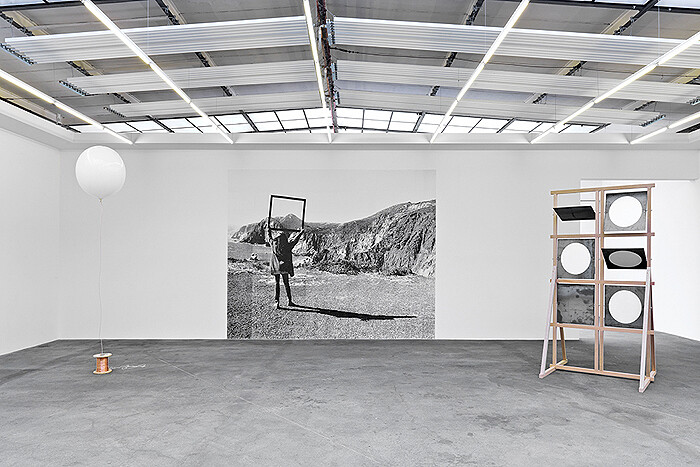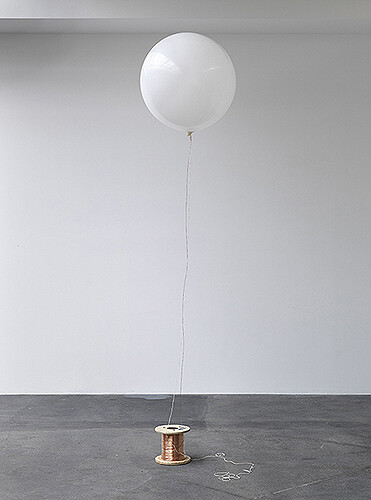Strictly speaking, you cannot interpret information; you can only decode it. Information is technical in nature; it concerns the precision with which a series of symbols are transmitted across a medium. These symbols can consist of anything—black font on paper, electrical pulses, colored flags.
“Low Visibility,” the first Berlin solo show by Argentinean artist Amalia Pica, revisits several outmoded information technologies—a recurring theme in Pica’s work. Shutter Telegraph (as seen on TV) (2013), recreates a shutter telegraph, one of the methods for optical communication that preceded the invention of electrical telegraphy. Also known as the Chappe telegraph after its inventor Claude Chappe, who devised it in 1792, or the Napoleonic Semaphore, the telegraph operates through the use of pivoting shutters or blades, placed atop a transmitting tower. Though the system was extremely successful in conveying intelligence—at its height, France had 556 telegraph stations—it had obvious atmospheric limitations. The gallery’s staff, unschooled in Morse code, is supposed to operate the shutters during the show, producing inevitably incoherent messages. Information is a measure of the freedom of choice, which is available when aligning a string of symbols. If I choose to start a sentence with “the,” chances are a noun will follow. The more meaningless a statement, the greater its coefficient of freedom.
Another piece in the show, The wireless way in low visibility (recreation of the first system for non cable transmission, as seen on TV) (2013), recreates Guglielmo Marconi’s turn-of-the-century experiments with wireless transmission. The system comprises a helium-balloon holding up a wire connected to a loading coil. This antenna is intended to emit electromagnetic radiation, which ought to travel outward in every direction until reaching the next receiving pole. As the ancillary caption explains, in crucial attempts at transatlantic transmission, Marconi’s balloons were swept away by a storm and the system was abandoned shortly thereafter.
Retrophilic as it all may sound, as the extended title as seen on TV hints, Pica is not so much interested in the technical difficulties of fraught information systems as she is attentive to the way communication—operating below the threshold of consciousness—breeds congruity and compliance. As Wittgenstein once noted, it is possible to train children to look at something by pointing at it, whereas cats react in a seemingly random variety of ways. People display a remarkable uniformity in standard reactions. These observations, however trivial, led the philosopher to conclude that the very existence of the language rules that make communication possible rely on the potential for agreement found within human behavior.
Wittgenstein was, of course, not alone in his interest in speech acts and information transfer. All of modernity’s philosophical questions are, in one way or another, questions about social integration—how to make the many act as one—and all questions about social integration are, roughly put, questions about communication.
Needless to say, the conceptual distinction between information and meaning can only emerge after it becomes technically possible to separate speech from the speaker. This all seemed rather benign until Norbert Wiener’s cybernetics—drenched in cold-war hues—made its entry onto the world stage. Wiener’s take on communication theory shed the terms “shareability” and “meaning” to stress the link between communication and control. Forget kitties and little children or Locke’s lofty assumptions about “linking isolated individuals through bonds of language”; we are now talking about coupling statistical information and control theory in order to describe society and social interaction as a trivial, self-replicating machine.
In what could be an allegory gone awry for Wiener’s “control and communication in the animal and the machine,” Pica’s Playing solo and indoors (mechanical jump rope) (2013), forces a hapless performer into a game of skipping. While the rope, swung by a mechanical contraption, maintains an unwavering pace, the performer recounts his daily errands in excruciating detail. The relentlessly repetitive exercise emphasizes how individuation and socialization run on a narrative loop, and how leisurely games act as instances of informal training, reinforcing integration and discipline.
As the show’s press release points out, “all forms are political, (…) and all politics become form” (quoting Nuit Banai’s review of Pica’s show at MIT’s List Visual Arts Center in Artforum). Yet it is easier to read the politics of aesthetics than to set out to track the emergent forms of the political—the task Pica often undertakes. Cybernetics, as we all know, went on to become the scientific ideology of neoliberalism, the denouement of which was the late-eighties notion of the “end of history,” imposing the wide cultural convergence of an iterative liberal economy as the final form of human government.
In the exhibition’s final room, sedition takes on the form of visual poetry. The series of works titled “Catachresis” (2013) materialize a number of figurative expressions such as the eye of a needle or the teeth of a saw in several Dada-like readymade assemblages. Derrida once referred to catachresis as a strained trope, a haphazard figure of speech, which reveals how equally strained what one takes as the proper sense can be. Perhaps the duplicity of figurative language will always contrast with the unequivocalness of encoding. Perhaps the singular cannot fully be deduced from the social. As if coming full circle, in the gallery’s main hall, facing the entrance, Pica installed a wallpaper-sized picture of herself holding up a frame against a mountainous landscape. Establishing a link between figurality and performativity, Constructed View #2 (2013) directs the acquiescing viewer’s gaze straight to this little piece of over-the-counter romanticism.








